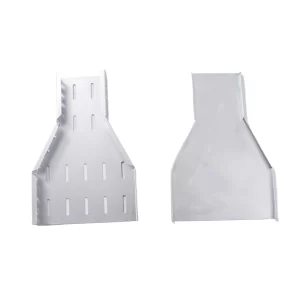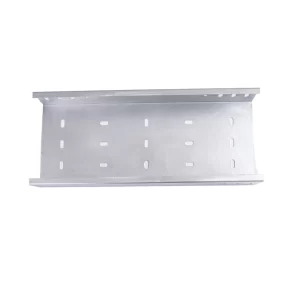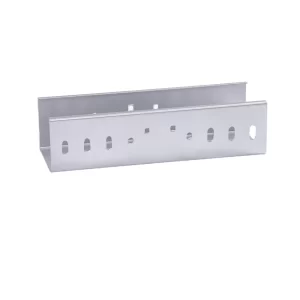In the world of electrical installations and cable management, choosing the right size cable tray is crucial for ensuring the safety, efficiency, and longevity of your system. Cable trays are used to support and organize electrical cables, protecting them from damage and facilitating easy access for maintenance and troubleshooting. But with so many different sizes and types of cable trays available, determining the correct size for your specific application can be a complex task. In this article, we will explore the factors to consider when determining the size of cable tray you need.

Cable trays are an essential component of any electrical installation, providing a structured and organized way to route cables throughout a building or industrial facility. They come in a variety of materials, including steel, aluminum, and fiberglass, and can be configured in different shapes and sizes to meet the specific needs of your project.
The size of the cable tray you choose will depend on several factors, including the number and size of cables to be accommodated, the installation environment, and any applicable building codes and regulations. Choosing the right size cable tray is essential for ensuring proper cable management, minimizing the risk of cable damage, and ensuring compliance with safety standards.
Factors to Consider When Choosing Cable Tray Size
1. Number and Size of Cables
The first factor to consider when choosing cable tray size is the number and size of cables that will be routed through the tray. You need to determine the total cross-sectional area of the cables and select a cable tray that can accommodate this area without overcrowding.
To calculate the cross-sectional area of your cables, you can use the following formula: Cross-sectional area = π * (cable diameter/2)^2. Add up the cross-sectional areas of all the cables to determine the total area.
Cable trays are typically available in different widths and depths, so you can choose a tray that provides enough space for your cables while also allowing for some room for future expansion.
2. Installation Environment
The installation environment also plays a significant role in determining the size of cable tray you need. Consider factors such as the location of the installation (indoor or outdoor), the presence of moisture, dust, or corrosive substances, and any temperature or humidity variations.
For outdoor installations or areas with high moisture levels, you may need to choose a cable tray made of a corrosion-resistant material such as stainless steel or fiberglass. These materials can withstand the elements and provide long-term protection for your cables.
In areas with high temperatures or where there is a risk of fire, you may need to choose a cable tray with a higher fire rating to ensure the safety of your installation.
3. Future Expansion
When choosing cable tray size, it is essential to consider future expansion plans. If you anticipate adding more cables or equipment in the future, you should select a cable tray that can accommodate this growth without requiring extensive modifications or replacements.
Leave some extra space in the cable tray to allow for future additions, or choose a tray that can be easily expanded or modified if needed. This will save you time and money in the long run and ensure that your cable management system remains flexible and adaptable.
4. Building Codes and Regulations
Different regions and industries have specific building codes and regulations regarding cable tray installation. These codes may specify minimum sizes, load capacities, and fire ratings for cable trays.
Make sure to familiarize yourself with the applicable building codes and regulations in your area and choose a cable tray that complies with these requirements. This will ensure the safety and legality of your installation and help you avoid potential fines or penalties.

Types of Cable Trays and Their Sizes
1. Ladder Cable Trays
Ladder cable trays are one of the most common types of cable trays. They consist of two side rails connected by rungs or cross-members, creating a ladder-like structure. Ladder cable trays are available in a wide range of sizes and can accommodate a large number of cables.
The width and depth of ladder cable trays can vary depending on the application. Smaller trays may be suitable for residential or light commercial installations, while larger trays are used in industrial settings or for high-capacity cable runs.
Ladder cable trays are often available in standard lengths, but they can also be cut to size or joined together to create longer runs as needed.
2. Tray Cable Trays
Tray cable trays are similar to ladder cable trays but have a solid bottom instead of rungs. This makes them more suitable for applications where cables need to be protected from dust, debris, or water.
Tray cable trays come in various sizes and can be customized with different accessories such as covers, dividers, and cable supports. They are often used in indoor installations where aesthetics and cable protection are important.
3. Channel Cable Trays
Channel cable trays are U-shaped trays that are typically used for smaller cable runs or in areas where space is limited. They are available in different sizes and can be mounted on walls or ceilings.
Channel cable trays are often made of steel or aluminum and can be painted or powder-coated to match the decor of the installation environment.
4. Wire Mesh Cable Trays
Wire mesh cable trays are made of welded wire mesh and offer excellent ventilation and visibility. They are suitable for applications where heat dissipation is a concern or where cables need to be easily inspected.
Wire mesh cable trays come in a variety of sizes and can be customized with different mesh openings and load capacities. They are often used in data centers, industrial plants, and other environments where high-performance cable management is required.

How to Measure and Determine Cable Tray Size
1. Measure the Total Length of the Cable Run
Before choosing a cable tray size, you need to determine the total length of the cable run. This will help you determine the number of trays needed and the overall size requirements.
Measure the distance from the source of the cables to the destination, taking into account any bends, turns, or vertical rises in the cable route.
2. Calculate the Cable Fill Percentage
Cable trays are designed to be filled to a certain percentage to ensure proper ventilation and cable management. The fill percentage varies depending on the type of cable tray and the installation environment.
Generally, cable trays should be filled to no more than 40% to 50% of their capacity to allow for proper air circulation and easy access to cables. Calculate the total cross-sectional area of the cables and divide it by the cross-sectional area of the cable tray to determine the fill percentage.
3. Consider Accessories and Spacing Requirements
In addition to the cables themselves, you need to consider any accessories that will be installed in the cable tray, such as cable supports, dividers, and covers. These accessories will take up additional space and need to be accounted for when determining the cable tray size.
Also, consider the spacing requirements between cables and between the cables and the sides of the tray. This will ensure proper ventilation and prevent overheating of the cables.
Choosing the right size cable tray is essential for ensuring the safety, efficiency, and longevity of your electrical installation. By considering factors such as the number and size of cables, the installation environment, future expansion plans, and building codes and regulations, you can select a cable tray that meets your specific needs and provides reliable cable management. Take the time to measure and calculate accurately, and consult with a professional if needed, to ensure that you choose the correct size cable tray for your project.
